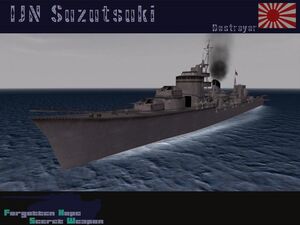| IJN Suzutsuki | |
|---|---|

| |
| General information | |
| Place of origin | Japan |
| Category | Destroyer |
| Class | Akizuki class |
| Sister ships | Fuyuzuki Hatsuzuki |
| Used by | Japan |
| Speed | 61 km/h |
| Special abilities | Radar Sonar |
| Seat 1 | |
| Primary weapon | 4x 10 cm Type 98 ↑ HE ↓ AA |
| Secondary weapon | 10x Depth charges |
| Seat 2 | |
| Primary weapon | 4x 10 cm Type 98 ↑ HE ↓ AA |
| Secondary weapon | 3x 25 mm Type 96 999x45 rounds |
| Seat 3 | |
| Primary weapon | 16x 25 mm Type 96 999x45 rounds |
| Seat 4 | |
| Primary weapon | 16x 25 mm Type 96 999x45 rounds |
| Seat 5 | |
| Primary weapon | 4x 61 cm Type 93 Torpedo Tubes |

| |
The Akizuki class destroyers were the largest, most modern and successful destroyers of the Japanese Navy in the World War II. They were 134 feet long and had a combat uniform displacement of 3,700 tons. They were built in 1940 and were intended primarily as an escort for the Japanese aircraft carriers to protect them from enemy planes. Their armanent consisted of eight fast-firing long-range multi-purpose guns and a vast number of smaller AA weapons.
As they had a radar, they could also fight at night. These large destroyers were often confused with cruisers by their opponents. This is due to the curved smooth deck, four distinctively shaped twin towers and the arrangement of the structures. In fact, they were used in some cases as flagships Japanese Navy Battle Groups. The Akizukis were involved to every major Japanese naval operation from mid-1942, including the battles of Guadalcanal, where they secured supplies to the Japanese troops, in the Solomon Islands as a carrier escort and finally at Leyte Gulf.
They proved to be an excellent and versatile destroyers, whose anti-aircraft armament was constantly reinforced. Six of the twelve completed until the war ended Akizuki class destroyers were lost in the course of hostilities. The surviving six ships were further used by other countries for many years after the war. Suzutsuki (涼月?) was an Akizuki-class destroyer of the Imperial Japanese Navy. Her name means "Clear Moon (in Autumn)".
In October 1944, renovations took placeon the Suzutsuki , in the course of which was the number of anti-aircraft guns geratly increased. In the game the armament is almost 1:1 consistent with this version, missing only two 25-mm guns drillings.
On 6–7 April 1945, Suzutsuki escorted Yamato from the Inland Sea on her attack mission against the Allied forces fighting on Okinawa. Her bow was torn off by a torpedo from aircraft of Task Force 58, but survived and returned to Sasebo, by steaming in reverse the whole way. She, her sister Fuyuzuki, Yukikaze, and Hatsushimo (sunk two days later by a mine off the Inland Sea), survived the ordeal, despite suffering heavy damage, but Yamato, and five escorts, Yahagi, Asashimo, Kasumi, Hamakaze and Isokaze were all sunk with heavy losses of life. Some of the survivors were picked up by Suzutsuki.
In FHSW, by the generally improved air defense you can also fight effectively against medium and as well heavy bombers. Bomber pilots should not underestimate the Suzutsuki, both the strong anti-aircraft weapons as well as their high maneuverability make it a difficult target. The torpedoes ensure that you can even damage larger vessels , which is particularly important for individual operations against enemy aircraft carriers.
You have no chance in direct competition with a battleship, even with the torpedoes, as one salvo from the main artillery sank the Hatsuzuki.
| |||||||||||||||||||||||||||||
